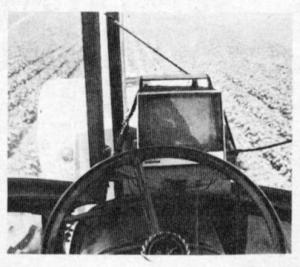1980 - Volume #4, Issue #1, Page #08
[ Sample Stories From This Issue | List of All Stories In This Issue | Print this story
| Read this issue]
Super Cultivator Uses TV to Find Feeds
 |
John Jensen, of Ankeny, uses a closed circuit TV set as a part of his "super cultivator". His total weed control equipment consists of the basic cultivator, standard spray nozzles, drop nozzles, and a handgun all mounted on a folding Orthman toolbar.
A television camera with a wide angle lens looks out on the field ahead of the cultivation rig. It spots weed problems, then projects them on the TV screen located inside the tractor cab. Jensen can flick electronic controls to turn on 4, 8, or 12 rows of nozzles to apply chemicals where he needs them. On the edge of the field or along roadsides, he can spray hardto-reach places with the handgun operated manually or automatically.
Jensen put together his cultivator rig himself, which consists of four basic 6-nozzle disk kits mounted on the tool bar.
A high volume Hypro pump (which delivers 120 gal. per minute) and a 500 gal. frontmounted tank make up the rest of the equipment.
All this is mounted on Jensen's 4-wheel drive John Deere 8640 tractor. On this model, the operator sits high enough to see over the tank.
The closed circuit television set is the type used on ships. The wide angle lens of the camera covers three rows, and the image is corrected from its usual reversed position on a monitor.
The television equipment cost about $750.
Jensen's location in eastern Iowa is ideal for television. He can pick up local stations and watch regular programs when he isn't monitoring weeds in his fields.
Jensen makes another use of closed circuit TV. He puts the camera on the grain wagon so he can see behind him when traveling down the road. And he has other ideas for it:
"I'm going to try to put a camera inside the combine so I can monitor what's happening inside during harvest. If something goes wrong, I'll see it before it causes trouble," he says. He figures that he will need a strong light and probably a fan to keep dust off the camera.
Lots of farmers have looked at, but not many have duplicated it, as far as he knows. The ability to spot-treat weeds in the field, rather than broadcast spraying every acre, has saved a lot of money. In soybeans, the cost has been about one-fourth of what it would be with broadcasting, Jensen points out.
For more details, contact: John Jensen, FARM SHOW Followup, Rt. 1, Ankeny, Iowa 50021 (ph 515 964-1261).

Click here to download page story appeared in.

Click here to read entire issue
To read the rest of this story, download this issue below or click here to register with your account number.




